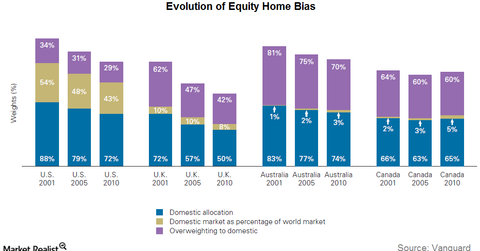The Equity Home Bias Puzzle
In this series, we’ll look at the prevalence of home bias, the disadvantages of favoring home bias, and the benefits of international diversification.
Sept. 1 2020, Updated 9:57 a.m. ET

Leaving Bias at Home
The benefits of investing internationally have been well documented, and yet investors have continued to invest a disproportionate amount in stocks listed on their home market. This phenomenon, known as home bias, is still prevalent with investors today. In fact, recent data show that although non-U.S. equities comprised 51% of the global equity market, U.S. investors invested only 27% of their portfolios, on average, in international stocks. Clearly, many American investors have been overlooking opportunities abroad. Portfolios with diversified assets may be able to withstand a greater variety of market conditions because risk is spread among different markets with different market cycles. This can potentially stabilize portfolio returns over the long term. In addition, diversifying internationally is a way for investors to be early movers in emerging economies that may be more volatile but could experience faster growth than developed economies. This paper aims to demonstrate that portfolios with diversified assets, and specifically portfolios utilizing closed-end funds, are able to withstand a greater variety of market conditions and outperform over the long term.

Market Realist – What is equity home bias?
Equity home bias refers to investors’ tendencies to allocate most of their portfolios to domestic equities (SPY) (IVV) despite the diversification benefits foreign equities may provide. Keeping all your eggs in one basket is a surefire way to invite trouble. Diversification should not only mean diversifying across various industries of the same country but also diversifying assets across nations (FAM).
Home bias isn’t limited to the United States. You can see in the above graph the historical evolution of home bias across selected nations.
Reasons for home bias
The following are some factors that propagate home bias[1. source: Vanguard]:
- Expectations about future returns by investors in their home markets are often considered a key driver that encourages home bias.
- Investors tend to adopt the policy of choosing the known devil, so to speak. Home markets breed familiarity and comfort among investors, increasing their affinity to stick close to home. Investors are also more aware of the corporate governance practices of their own nations. So they might avoid countries with dubious corporate governance standards such as Japan (JEQ), India (IFN), and China (GCH).
- Investors tend to consider investing in foreign markets risky due to currency gyrations. Exchange rate fluctuations tend to lend volatility (VXX) to international equities (ACWI). That’s often why investors choose domestic equities over international equities.
- Investors often foster the misconception that investing in multinational companies domiciled in their home countries could achieve the same benefits as investing in foreign equities.
In this series, we’ll look at the prevalence of home bias, the disadvantages of favoring home bias, and the benefits of international diversification.
